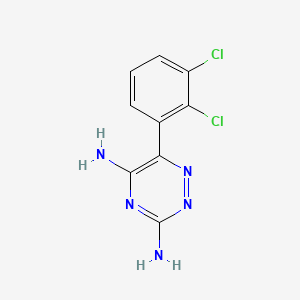
Lamotrigine
Katalognummer B1674446
Molekulargewicht: 256.09 g/mol
InChI-Schlüssel: PYZRQGJRPPTADH-UHFFFAOYSA-N
Achtung: Nur für Forschungszwecke. Nicht für den menschlichen oder tierärztlichen Gebrauch.
Patent
US04649139
Procedure details


A solution of 2,3-dichlorobenzoyl cyanide (32 g, 0.16M) in dimethylsulphoxide (80 ml) was added dropwise to a stirred suspension of aminoguanidine bicarbonate (81.67 g. 0.6M) which had been treated with 8N aqueous nitric acid (400 ml) at a temperature of ca 25° C. The mixture was stirred for 3 hours, then left to stand at room temperature for 7 days. The cooled mixture was stirred and basified with 0.880 aqueous ammonia (400 ml) at 20° C., then stirred with ice cooling for 30 minutes. The resulting solid was separated by filtration, washed thoroughly with water and finally dried in vacuo. The above solid was added to a 10% w/v solution of potassium hydroxide pellets in methanol (400 ml) and the solution heated to reflux for 11/2 hours. When cool the solution was evaporated down in vacuo, treated with ice water (800 ml) then stirred for 30 minutes and filtered. The residue was dried and recrystallised from isopropanol to give 3,5-diamino-(2,3-dichlorophenyl)-1,2,4-triazine Yield 6.8 g (15.6%), m.p. 216°-218° C. (uncorrected).





Yield
15.6%
Identifiers


|
REACTION_CXSMILES
|
[Cl:1][C:2]1[C:11]([Cl:12])=[CH:10][CH:9]=[CH:8][C:3]=1[C:4]([C:6]#[N:7])=O.C(=O)(O)O.[NH2:17][NH:18][C:19]([NH2:21])=[NH:20].[N+]([O-])(O)=O.N>CS(C)=O>[NH2:20][C:19]1[N:18]=[N:17][C:4]([C:3]2[CH:8]=[CH:9][CH:10]=[C:11]([Cl:12])[C:2]=2[Cl:1])=[C:6]([NH2:7])[N:21]=1 |f:1.2|
|
Inputs


Step One
|
Name
|
|
|
Quantity
|
32 g
|
|
Type
|
reactant
|
|
Smiles
|
ClC1=C(C(=O)C#N)C=CC=C1Cl
|
|
Name
|
|
|
Quantity
|
81.67 g
|
|
Type
|
reactant
|
|
Smiles
|
C(O)(O)=O.NNC(=N)N
|
|
Name
|
|
|
Quantity
|
80 mL
|
|
Type
|
solvent
|
|
Smiles
|
CS(=O)C
|
Step Two
|
Name
|
|
|
Quantity
|
400 mL
|
|
Type
|
reactant
|
|
Smiles
|
[N+](=O)(O)[O-]
|
Step Three
|
Name
|
|
|
Quantity
|
400 mL
|
|
Type
|
reactant
|
|
Smiles
|
N
|
Conditions


Stirring
|
Type
|
CUSTOM
|
|
Details
|
The mixture was stirred for 3 hours
|
|
Rate
|
UNSPECIFIED
|
|
RPM
|
0
|
Other
|
Conditions are dynamic
|
1
|
|
Details
|
See reaction.notes.procedure_details.
|
Workups


WAIT
|
Type
|
WAIT
|
|
Details
|
left
|
WAIT
|
Type
|
WAIT
|
|
Details
|
to stand at room temperature for 7 days
|
|
Duration
|
7 d
|
STIRRING
|
Type
|
STIRRING
|
|
Details
|
The cooled mixture was stirred
|
STIRRING
|
Type
|
STIRRING
|
|
Details
|
stirred with ice cooling for 30 minutes
|
|
Duration
|
30 min
|
CUSTOM
|
Type
|
CUSTOM
|
|
Details
|
The resulting solid was separated by filtration
|
WASH
|
Type
|
WASH
|
|
Details
|
washed thoroughly with water
|
CUSTOM
|
Type
|
CUSTOM
|
|
Details
|
finally dried in vacuo
|
ADDITION
|
Type
|
ADDITION
|
|
Details
|
The above solid was added to a 10% w/v solution of potassium hydroxide pellets in methanol (400 ml)
|
TEMPERATURE
|
Type
|
TEMPERATURE
|
|
Details
|
the solution heated
|
TEMPERATURE
|
Type
|
TEMPERATURE
|
|
Details
|
to reflux for 11/2 hours
|
|
Duration
|
2 h
|
TEMPERATURE
|
Type
|
TEMPERATURE
|
|
Details
|
When cool the solution
|
CUSTOM
|
Type
|
CUSTOM
|
|
Details
|
was evaporated down in vacuo
|
ADDITION
|
Type
|
ADDITION
|
|
Details
|
treated with ice water (800 ml)
|
STIRRING
|
Type
|
STIRRING
|
|
Details
|
then stirred for 30 minutes
|
|
Duration
|
30 min
|
FILTRATION
|
Type
|
FILTRATION
|
|
Details
|
filtered
|
CUSTOM
|
Type
|
CUSTOM
|
|
Details
|
The residue was dried
|
CUSTOM
|
Type
|
CUSTOM
|
|
Details
|
recrystallised from isopropanol
|
Outcomes


Product
Details
Reaction Time |
3 h |
|
Name
|
|
|
Type
|
product
|
|
Smiles
|
NC=1N=NC(=C(N1)N)C1=C(C(=CC=C1)Cl)Cl
|
Measurements
| Type | Value | Analysis |
|---|---|---|
| AMOUNT: MASS | 6.8 g | |
| YIELD: PERCENTYIELD | 15.6% | |
| YIELD: CALCULATEDPERCENTYIELD | 16.6% |
Source


|
Source
|
Open Reaction Database (ORD) |
|
Description
|
The Open Reaction Database (ORD) is an open-access schema and infrastructure for structuring and sharing organic reaction data, including a centralized data repository. The ORD schema supports conventional and emerging technologies, from benchtop reactions to automated high-throughput experiments and flow chemistry. Our vision is that a consistent data representation and infrastructure to support data sharing will enable downstream applications that will greatly improve the state of the art with respect to computer-aided synthesis planning, reaction prediction, and other predictive chemistry tasks. |
